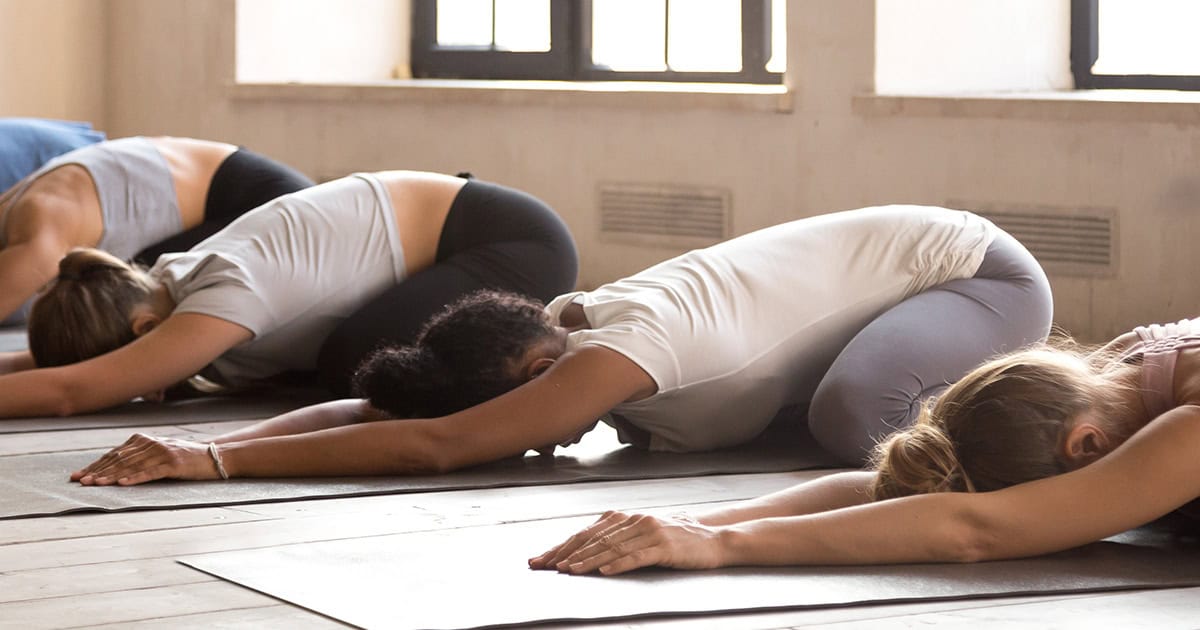Vaginismus Exercises: Yoga Poses and Stretches for Pelvic Floor Relaxation
This has been reviewed by Edward Evanstash, M.D., OB-GYN and Chief Medical Advisor for Materna Medical.
Yoga can calm the mind and body — including the vagina.
Yoga offers both physical and mental relaxation that is key to relieving vaginismus.* This painful condition involves involuntary tightening of the pelvic floor muscles, especially during intercourse, pelvic exams, or tampon use.
With its focus on gentle stretches, breath work, and mindfulness, yoga can reduce muscle tension, ease stress, and improve pelvic floor control—all of which help relieve vaginismus symptoms.
In this post, we’ll share yoga poses and exercises recommended by the pelvic floor physical therapists who teach Vagercise. This online educational and exercise course helps women suffering with pelvic floor dysfunction.
Table of Contents
How Yoga Helps with Vagina Tightening
For women struggling with pelvic floor tension and pain from vaginismus, yoga offers numerous benefits:
Pelvic Floor Stretches
Even basic yoga poses, such as child’s pose and happy baby, are known for stretching the muscles at the base of the pelvis and can be a gentle way to ease tension associated with vaginismus.
Plus, many yoga poses stretch muscles in the hips and lower back that connect to the pelvis. Tension in these muscles can cause tension in the pelvic floor, and vice versa, so better flexibility in these areas can improve pelvic floor function.
Breathing Practice
As you connect your breath with movement during yoga, you’re also helping to restore your pelvic floor function.
That’s because the diaphragm, the muscle below your lungs that helps you inhale and exhale, moves in tandem with your pelvic floor.
When you inhale, both the diaphragm and pelvic floor muscles move downward. When you exhale, the diaphragm automatically rises, and your pelvic floor lifts along with it.
Pelvic floor physical therapists often recommend breathing exercises for women whose pelvic floor muscles are tight and contracted, stuck in a state of tension.
The diaphragmatic or 360-degree breathing encouraged in yoga—in which the breath expands your belly, sides, and back—may help lengthen the pelvic floor muscles and reduce tension.
Mindful Movement
Yoga connects the mind to the body, allowing you to notice areas of tension and consciously release them.
Working on muscles, you can’t see is difficult, so yoga can give you better awareness of your pelvic floor and help you better understand your pelvic floor and focus on relaxing the muscles when vaginismus symptoms arise.
Stress Reduction
Focusing on movement and breathing in yoga helps to clear your mind and manage stress.
Plus, deep breathing stimulates your vagus nerve to calm your central nervous system, which plays a role in the involuntary tightening of the vaginal muscles.
Yoga Poses and Stretches for Vaginismus Relief
Whether stretching alone or participating in a class, integrating yoga poses into your routine may help you find relief from vaginismus.
Focus on these yoga poses that target the pelvic floor muscles and supporting muscles in the hips and lower back that often contribute to pelvic floor tension.
The videos below are excerpts from Vagercise yoga classes taught by pelvic floor physical therapists who are certified yoga instructors.
Yogi Squat
A yogi squat provides a deep stretch for your pelvic floor and inner thighs while allowing you to feel the sensation of your breath relaxing your muscles.
Sit on a yoga block with your knees turned out and heels facing in.
Place your hands on the floor between your feet, or bring your palms together in a prayer position, with your elbows gently pushing into your inner thighs.
Take several rounds of deep breaths, allowing your pelvic floor to lengthen as you inhale and relax as you exhale.
Imagine your breath filling your belly and reaching down to your pelvic floor, opening the area between the tailbone and pubic bone.
Child’s Pose
More than a time-out during yoga class, child’s pose is an essential position that helps release tension in your pelvic floor, hips, and lower back.
As you kneel on the floor, spread your knees apart and bring your big toes together. Lower your chest to the floor, sitting back on your heels.
Walk your arms out and stretch to one side for several breaths, then switch sides.
Child’s pose also helps enable diaphragmatic breathing into the back, sides, and belly, not just the chest.
As you inhale, let your breath widen the area between your shoulder blades and fill your belly and pelvic floor.
As your body softens into the pose, spread your knees apart further for a deeper stretch.
Happy Baby
In addition to providing a deep stretch for the pelvic floor and inner thigh muscles, the happy baby pose offers another opportunity to feel the effects of deep breathing on your pelvic floor.
Lying on your back, bring your knees toward your chest and grab the outer edges of your feet.
Keep your shoulders and back pressed into the mat, being careful not to lift your sacrum at the base of your spine.
Be mindful not to clench your pelvic floor or inner thighs, focusing on relaxing the muscles with each breath.
Vaginismus Exercises to Reduce Vaginal Tightening
A good vaginismus exercise routine includes stretches and exercises that help you improve your pelvic floor awareness and mobility.
Try these exercises, taught by pelvic floor PTs in Vagercise online classes, to release tension in the pelvic floor while helping you learn to control your muscles consciously.
Diaphragmatic Breathing on a Rolled Blanket
It takes practice to connect your breath and pelvic floor. Sitting on a rolled blanket or towel can help you recognize the sensation of your muscles lengthening with your breath.
Sit on the floor in a cross-legged position, with the blanket positioned under your perineum, in between your sitz bones.
As you inhale deeply, allow your breath to expand your belly, sides, and back.
Focus on the feeling of your pelvic floor muscles relaxing into the blanket as you inhale and recoiling as you exhale.
Don’t force or push your pelvic floor muscles toward the blanket. As you practice several rounds of breath, the movement of your pelvic floor should feel natural.
Windshield Wipers
If your hips are tight, your pelvic floor probably is, too.
With some hip muscles attaching inside the pelvis, your hips need a full range of mobility to allow your pelvic floor muscles to stretch and relax.
The windshield wiper exercise helps warm the hips and pelvic floor, allowing the muscles to relax in subsequent stretches.
Sit on the floor with your feet in front, your hands behind you, and your knees spread apart. Move both knees from side to side, letting the inside knee touch the floor.
Cat/Cow
Tension in the lower back and hips can limit the movement of the pelvis and spine, worsening pelvic floor issues like vaginismus.
Flowing between the cat and cow poses emphasizes pelvic mobility, helping to relax the pelvic floor muscles.
Start in an all-fours position, with your shoulders stacked over your wrists and your hips over your knees.
Inhale as you move into the cow position, arching your spine and lifting your chest and tailbone.
As you exhale into the cat position, round your back and drop your tailbone, pushing the floor away.
Focus on your pelvis’s movement as you transition between poses, taking deep breaths that lengthen your pelvic floor.
Vaginal Tricks to Relax and Improve Comfort
Yoga is an important tool for relieving tight pelvic floor muscles, but for many women, managing vaginismus requires a holistic approach.
In addition to stretches and exercises, try these vaginal tricks to promote relaxation and reduce discomfort.
Use a Vaginal Dilator
A vaginal dilator inserts into the vagina to gently stretch and expand the muscles, preparing you for penetration.
Milli is the first all-in-one dilator that gradually expands within your vagina at a pace you control and offers optional vibration for additional comfort.
The dilator’s starting size is just over half an inch and adjusts one millimeter at a time, allowing you to avoid uncomfortable size increases and the discomfort of removal and re-insertion associated with static dilators.
Apply a Warm Compress
Applying a warm compress to the pelvic area can help relax the pelvic floor muscles and ease tightness.
Try placing a heating pad or warm towel over your lower abdomen and pelvic region while breathing deeply and focusing on relaxation.
Gently Massage the Area
Apply a small amount of lubricant to the vaginal opening and gently massage the surrounding area using slow, circular motions. Focus on relaxation, allowing the muscles to soften over time.
Try Meditation
Progressive muscle relaxation through meditation helps you identify and release tension in specific body parts.
Vagercise offers meditation led by a pelvic floor PT. The PT guides you through a session focusing on releasing pelvic floor tension through relaxation and breathing techniques.
You don’t have to live with the physical and emotional pain of vaginismus.
It takes time and effort to improve your symptoms, but resources like the Milli vaginal dilator and Vagercise online classes can help you stay consistent and make progress over time at your own pace.
By incorporating pelvic floor relaxation, stretches, and yoga techniques into your routine, you can reclaim your body and your comfort again.
*Reference:
Tosun ÖÇ, Dayıcan DK, Keser İ, Kurt S, Yıldırım M, Tosun G. Are clinically recommended pelvic floor muscle relaxation positions really efficient for muscle relaxation? Int Urogynecol J. 2022 Sep;33(9):2391-2400. doi: 10.1007/s00192-022-05119-3. Epub 2022 Feb 24. PMID: 35201370.






